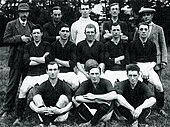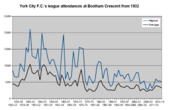York City F.C.
[10] In the 1937–38 FA Cup, they eliminated First Division teams West Bromwich Albion and Middlesbrough, and drew 0–0 at home to Huddersfield Town in the sixth round, before losing the replay 2–1 at Leeds Road.[11] York had been challenging for promotion in 1937–38 before faltering in the closing weeks, and in the following season only avoided having to apply for re-election with victory in the penultimate match.[46] In 1981–82, York endured a club-record run of 12 home matches without victory, but only missed out on promotion in 1982–83 due to their poor away form in the second half of the season.[49] In January 1985, York recorded a 1–0 home victory over First Division Arsenal in the fourth round of the 1984–85 FA Cup, courtesy of an 89th-minute penalty scored by Keith Houchen.[66] The Supporters' Trust (ST) bought the club in March 2003[67] after an offer of £100,000 as payment for £160,000 owed in tax was accepted by the Inland Revenue.[68] Batchelor left having diverted almost all of the £400,000 received from a sponsorship deal with Persimmon to his racing team,[69] and having failed to deliver on his promise of having ST members on the board.[73] York only avoided relegation late into their first Conference National season in 2004–05,[74] before reaching the play-off semi-final in 2006–07, when they were beaten 2–1 on aggregate by Morecambe.[75] Having only escaped relegation towards the end of 2008–09,[76] York participated in the 2009 FA Trophy final, and were defeated 2–0 by Stevenage Borough at Wembley Stadium.[78] York won their first national knockout competition two years later, after they beat Newport County 2–0 in the 2012 FA Trophy final at Wembley Stadium.[84] York were further relegated to the National League North for the first time in 2016–17;[85] however, they ended the season with a 3–2 win over Macclesfield Town at Wembley Stadium in the 2017 FA Trophy final.[92] The shirts bore a new crest in 1978, which depicted Bootham Bar, two heraldic lions and the club name in all-white, and in 1983 this was updated into a coloured version.[98] With the ground not ready, York played their first two home matches at Mille Crux, Haxby Road, before they took to the field at Fulfordgate for a 4–1 win over Mansfield Town on 20 September 1922.[104] There were teething problems in Bootham Crescent's early years: attendances were not higher than at Fulfordgate in its first four seasons, and there were questions over the quality of the pitch.[106] The Main Stand was extended towards Shipton Street over the summer of 1955, and a year later a concrete wall was built at the Grosvenor Road End, as a safety precaution and as a support for additional banking and terracing.[109] The David Longhurst Stand was constructed over the summer of 1991, and was named after the York player who collapsed and died from heart failure in a match a year earlier.[110][111] It provided covered accommodation for supporters in what was previously the Shipton Street End, and was officially opened for a friendly match against Leeds United.[123][124] Per the terms of the FSIF loan, the club was required to have identified a site for a new stadium by 2007, and have detailed planning permission by 2009, to avoid financial penalties.[130][131] In August 2014, the council named GLL as the preferred bidder to deliver an 8,000 all-seater stadium, a leisure complex and a community hub.[134] The club officially moved into the stadium in January 2021,[135] with the first match being a 3–1 defeat to AFC Fylde on 16 February,[136] which was played behind closed doors because of the COVID-19 pandemic in the United Kingdom.[145] York have been the subject of a number of independent supporters' fanzines, including Terrace Talk, In The City, New Frontiers, Johnny Ward's Eyes, Ginner's Left Foot, RaBTaT and Y Front.[147] John Sentamu, the Archbishop of York, became the club patron for 2007–08, having become a regular spectator at home matches as a season ticket holder.[155] Six players, Keith Walwyn, Billy Fenton, Alf Patrick, Paul Aimson, Arthur Bottom and Tom Fenoughty, have also scored more than 100 goals for the club.[155] The first player to be capped at international level while playing for York was Eamon Dunphy, when he made his debut for the Republic of Ireland against Spain on 10 November 1965.[161] The club's highest attendance at their former Fulfordgate ground was 12,721 against Sheffield United in the FA Cup on 14 January 1931,[162] while the lowest was 1,500 against Maltby Main on 23 September 1925 in the same competition.[168][169] The youngest player to play for the club is Reg Stockill, who was aged 15 years and 281 days on his debut against Wigan Borough in the Third Division North on 29 August 1929.[170] The oldest player is Paul Musselwhite, who played his last match aged 43 years and 127 days against Forest Green Rovers in the Conference on 28 April 2012.[174] Ownership Board Management and backroom staff York City's honours include the following:[3] League Cup Infobox kits Specific











York City F.C. (1908)York Community StadiumAdam HinshelwoodNational League2023–24Home coloursAway coloursThird coloursassociation footballEnglish football league system2024–25 seasonnon-League footballthe Football LeagueThird Division NorthFourth DivisionpromotedFA Cup1954–55Newcastle UnitedSecond DivisionWembley StadiumThird Division play-off final2003–04relegated2011–12 FA Trophythat seasonYork MinsterFulfordgateBootham CrescentHull CityScarboroughBarry JacksonNorman WilkinsonHistory of York City F.C. (1922–1980)History of York City F.C. (1980–present)Midland LeagueGrimsby TownelectionBarrowAccrington StanleyAshingtonWigan Borough1929–301932–331937–38 FA CupFirst DivisionWest Bromwich AlbionMiddlesbroughHuddersfield TownreplayLeeds Roadpromotion1937–38following seasonRoker Park1946–471949–501952–531954–55 FA CupArthur BottomHillsborough1957–58Third Division1958–59goal average1959–60League Cup1961–62Rochdale1963–64next season1965–661966–671968–691970–711971–721972–731973–741974–751976–771977–78 season1980–811929–30 season1981–821982–831983–84Arsenal1984–85 FA CuppenaltyKeith HouchenEuropean CupLiverpoolAnfieldfollowing season's FA Cupextra time1985–861986–871992–93play-offsCrewe Alexandraplay-off finalpenalty shoot-outSecond Division play-offsStockport County1995–96 League CupPremier LeaguedoubleOld TraffordEvertonfollowing season's League CupGoodison Park1998–99Douglas CraigJohn BatcheloradministrationInland RevenuePersimmonFootball Conference2012 FA Trophy finalConference National2006–07Morecambe2008–092009 FA Trophy finalStevenage Borough2010 Conference Premier play-off final